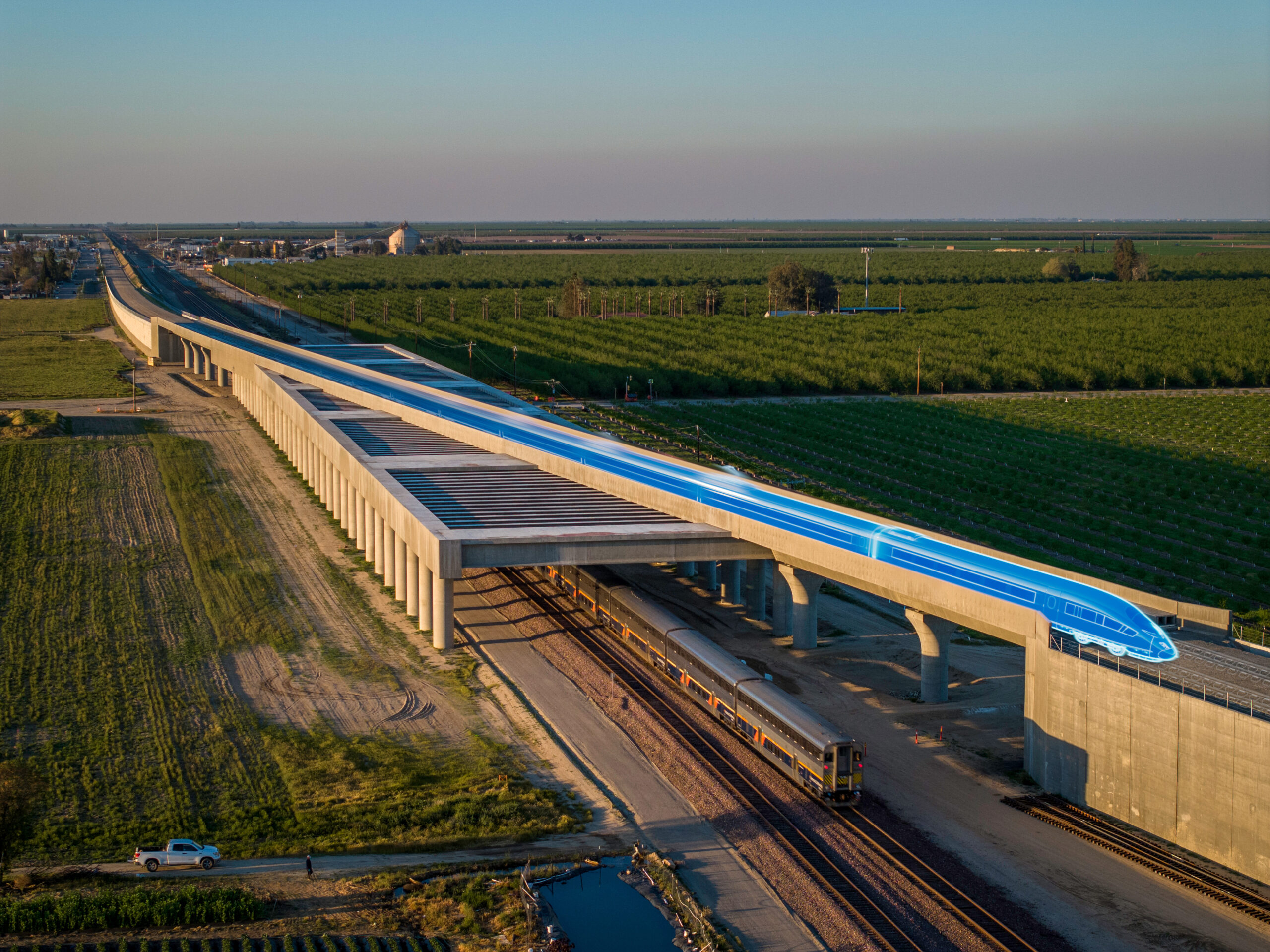
California High-Speed Rail – the largest infrastructure program underway in the U.S. – will accelerate connectivity between the state’s mega-regions and serve as a testament to the power of high-speed systems
DESIGNER
2024
California High-Speed Rail (CAHSR), the nation’s first high-speed rail project and largest in-process infrastructure program, will zip passengers along a nearly 500-mile route between San Francisco and Los Angeles at speeds up to 220 miles per hour. Electrified trains will cover the distance in fewer than three hours, cutting in half the six-plus hours it now takes to drive between the two cities.
The system’s backbone is the 119-mile initial operating section now under construction. Among the section’s three design-build construction packages is Construction Package 4 (CP4), a 22-mile segment that is critical to the line’s overall success. CP4 provides crucial rail guideway infrastructure that prepares for the program’s next steps: track and systems installation. Partnering with the project owner, California High-Speed Rail Authority, HNTB serves as construction manager.
“We achieved a construction first for high-speed rail in California with the completion of Construction Package 4. The HNTB team was instrumental in working with the Authority to achieve this milestone,” said Daniel Teran, senior contract manager, California High-Speed Rail Authority.
Transformational infrastructure
CAHSR represents a transformational and generational shift that will deliver considerable regional and statewide benefits, resolving congestion in communities, reducing greenhouse gas emissions and enhancing quality of life.
While the California High-Speed Rail Authority is working to secure funding for delivery of the entire CAHSR system, the project already has received state and federal funding for the work underway, and the Federal Railroad Administration announced in December 2023 that it would award $3 billion more for continuation of CAHSR design and construction.
The project also enjoys public support. A 2022 University of California Berkeley/Los Angeles Times survey found that the majority of California’s registered voters favored continuing the CAHSR project.
“There has been a perception that high-speed rail couldn’t be built in the United States,” said Alberto King, HNTB project executive. “But, through CAHSR, we are solving the issues that have previously stood in the way. HNTB is working collaboratively with the California High-Speed Rail Authority to address every challenge we encounter. We have not hesitated to bring the best available rail staff in the country to advise the Authority about the most effective ways to deliver the project.”
“HNTB is deeply passionate about the mission of high-speed rail in California,” said Brian Stover, HNTB project manager. “Bringing high-speed rail to the United States offers new options for accessible mobility, allowing people to travel between cities comfortably, reliably and safely. We’re taking what has been done in other parts of the world and making it better.”
Path through the Central Valley
The CAHSR line will traverse California’s Central Valley, the largest agricultural center in the country and home to nearly 7 million people.
“Although some communities in the Central Valley are the fastest growing in California, the region’s economy has lagged behind the rest of the state. Its communities have experienced historical underinvestment and have been geographically separated from the coastal cities,” King said. “By choosing to take high-speed rail through the Central Valley, the California High-Speed Rail Authority will not only deliver economic benefits to the communities along the route but will connect them to the rest of the state.”
The CAHSR line will make it easier for Central Valley residents to access the area’s more affordable housing and still commute to work in Los Angeles, the Bay Area or other job centers.
To ensure they weren’t contributing to the Central Valley Basin’s clean-air challenges, the Authority set a project goal of net-zero greenhouse gas and criteria pollutant emissions. During construction, all contractors must use trucks and equipment retrofitted to achieve comparable standards throughout the project. High-speed rail itself will monumentally reduce carbon emissions in the area by removing a significant number of cars and trucks from Central Valley roadways.
A substantially complete milestone
The CP4 project section, the southernmost construction package along the alignment, lies in the Central Valley within Tulare and Kern Counties. CP4 includes relocating and repurposing four miles of existing Burlington Northern Santa Fe (BNSF) tracks and construction of at-grade, retained fill and aerial sections of the high-speed rail alignment, including three viaducts over existing roadways and railroad tracks.
The segment includes the city of Wasco, where two key CAHSR structures were built:
- Wasco Viaduct: The nearly mile-long Wasco Viaduct will lift high-speed trains up and over the existing BNSF freight tracks. To avoid disruptions to the BNSF line, the project team chose a pergola structure with 120 precast concrete girders built over the tracks. Most of the precast elements were constructed on one side of the alignment, minimizing the impacts to BNSF operations and requiring only brief closures to set the girders. The structure above the pergola section will support a double high-speed slab track and allow a service speed of more than 200 miles per hour.
- Pedestrian Underpass: Located in the center of Wasco, the pedestrian underpass was built to allow Wasco residents to safely access an existing Amtrak platform located on the east side of the high-speed rail alignment. The signature structure, by which Amtrak patrons can cross under the high-speed rail line to access the passenger platform on the other side, has stairwells and wheelchair ramps built on both sides for accessibility.
Although CP4 was the last of the three construction packages to begin, it was the first to reach substantial completion. That milestone, achieved in early 2024, sets the stage for track, catenary and electrical work to begin.
“HNTB’s rigorous risk management methodology brought predictability to CP4,” King said. “We categorized every risk, from environmental permits to stakeholder engagement and utility relocations, and assigned a certain duration to each one. We, therefore, could measure and nail down the project schedule and budget, resolve issues week after week and advance faster.”
Leading CP4 Delivery
HNTB partnered with the California High-Speed Rail Authority as prime consultant and project construction manager on the CP4 design-build project. The firm’s responsibilities included contract management; oversight of project controls, engineering, construction and environmental compliance; utility and third-party oversight and coordination, right-of-way coordination and validation and verification services.
In addition, HNTB provided oversight of final design and construction services for all elements of the segment, including:
- More than 22 miles of guideway
- 11 Structures
- 6 miles of intrusion protection barrier wall
- 143 utility relocations
- 62 Pacific Gas & Electric design packages
- 223 right-of-way parcels
- 88 land rights conveyance
To ensure successful delivery of all designs, HNTB’s internationally recognized high-speed rail experts conducted a rigorous, independent verification and validation utilizing a process that has been successfully applied on high-speed rail construction in both Asia and Europe.”
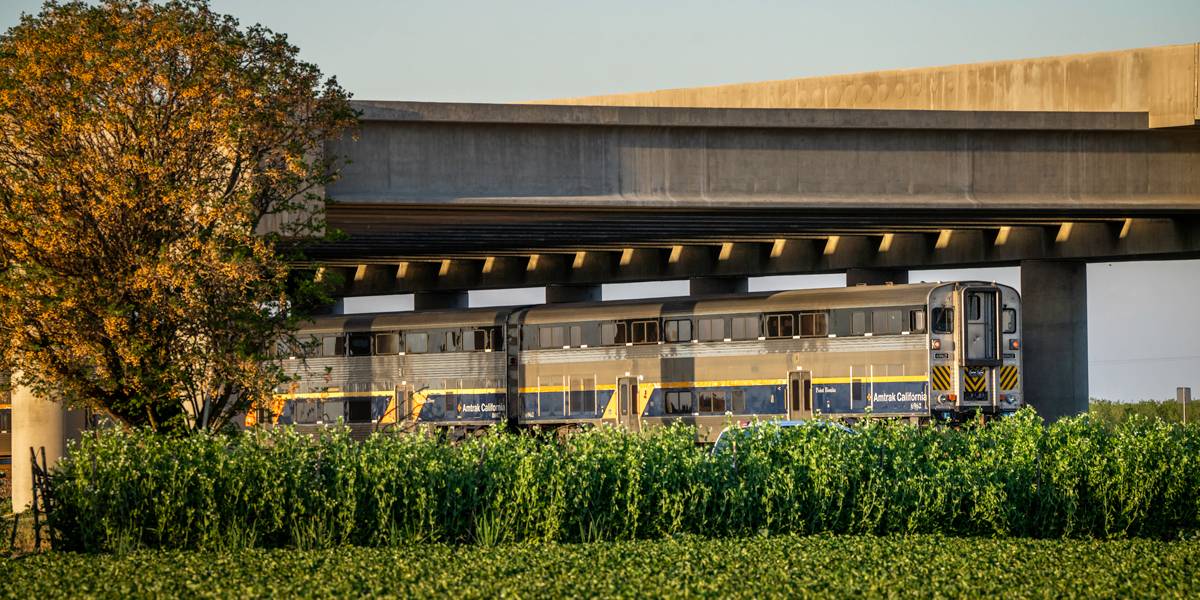
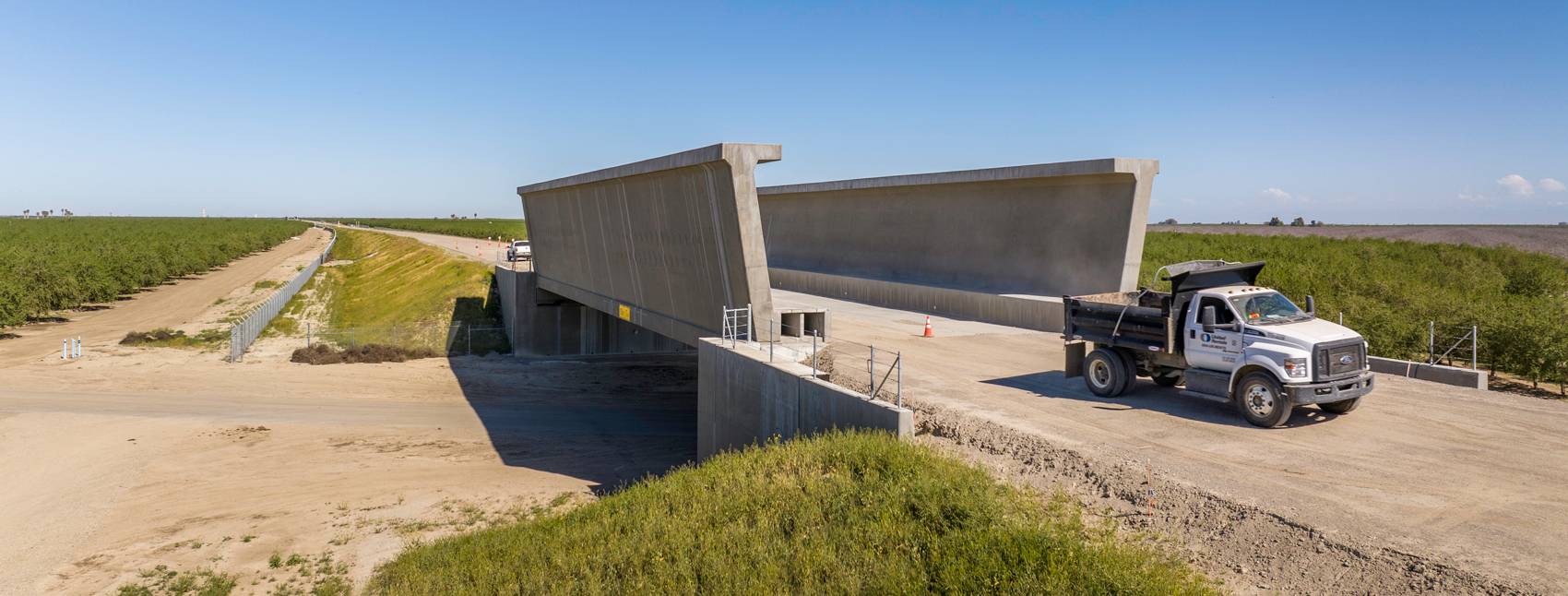
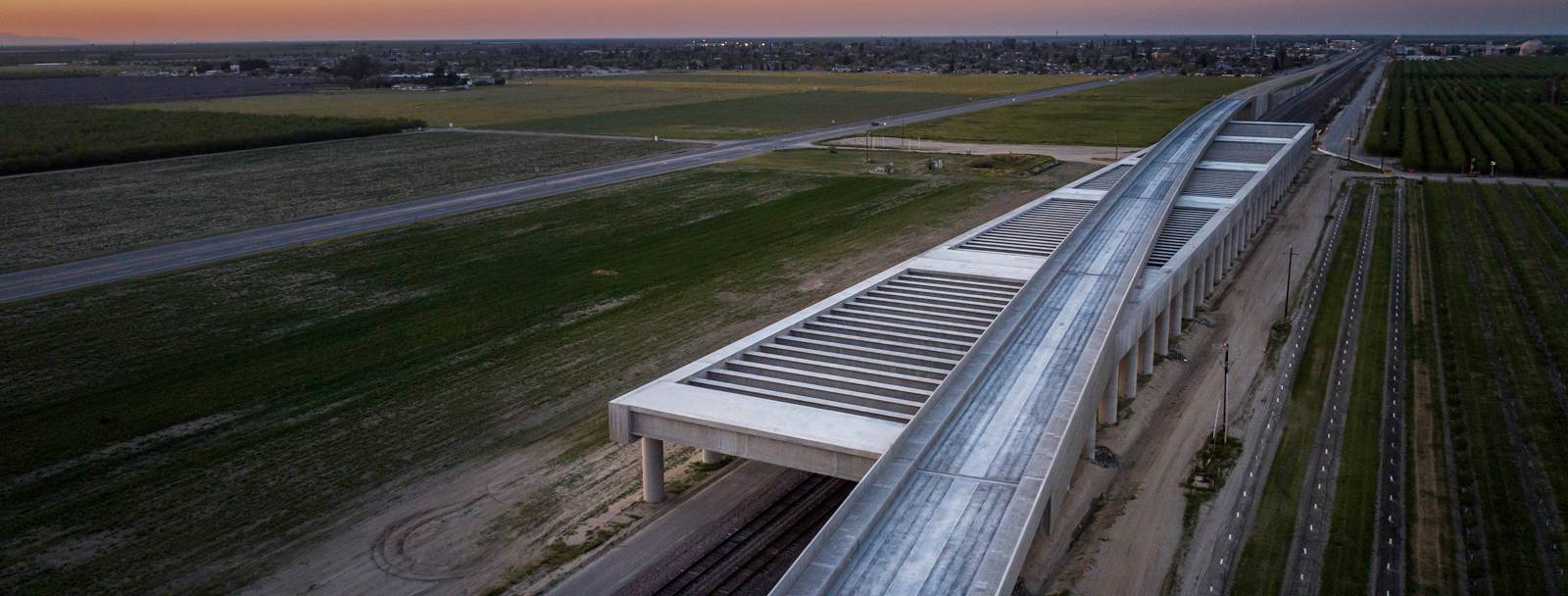
“We haven’t yet seen the effect high-speed rail can have on our lives. California High-Speed Rail is the proving ground for high-speed rail projects throughout the country. Once the system is operating and people begin to experience the convenience and understand the impact it has on their families, their work and their communities, the demand will escalate everywhere.”
“HNTB is deeply passionate about the mission of high-speed rail in California. Bringing high-speed rail to the United States is offers new options for accessible mobility, allowing people to travel between cities comfortably, reliably and safely. We’re taking what has been done in other parts of the world and making it better.”
“High-speed rail’s sweet spot is where it’s competitive with air, particularly where high-speed rail can operate from center city to center city. There’s a much higher reliability, weather issues are not as significant and the ability to expand capacity is easier because you can either add more trains or add more cars onto a train.”
A cohesive team, comprised of Authority, HNTB and contractor staff, enabled unified decision-making.
“We also worked closely with a number of the third parties, including City of Wasco leaders, with whom we held weekly meetings,” Stover said. “CP4 is an extremely complex project. Because a project like this has never been done in the United States, there were significant hurdles to overcome. HNTB created both systems and working relationships that enabled the whole team to collaborate and solve those issues together. That has been paramount to success.”
From its work on CP4, HNTB developed a lessons-learned log and met with designers from two additional CAHSR sections that are under design. The group reviewed issues that were encountered during CP4 construction that could be addressed and resolved in the design of future segments.
Inspiring the future of high-speed rail
As a fast, reliable and eco-friendly connection between California’s two biggest economic and population centers, CAHSR has the potential to be a powerhouse transportation alternative. The project is envisioned to eventually extend to Sacramento and San Diego, totaling 800 miles with as many as 24 stations.
“High-speed rail’s sweet spot is where it’s competitive with air, particularly where high-speed rail can operate from center city to center city,” said Peter Gertler, HNTB high-speed rail strategic advisor. “There’s a much higher reliability, weather issues are not as significant and the ability to expand capacity is easier because you can either add more trains or add more cars onto a train.”
“We haven’t yet seen the effect high-speed rail can have on our lives,” King said. “California High-Speed Rail is the proving ground for high-speed rail projects throughout the country. Once the system is operating and people begin to experience the convenience and understand the impact it has on their families, their work and their communities, the demand will escalate everywhere.”
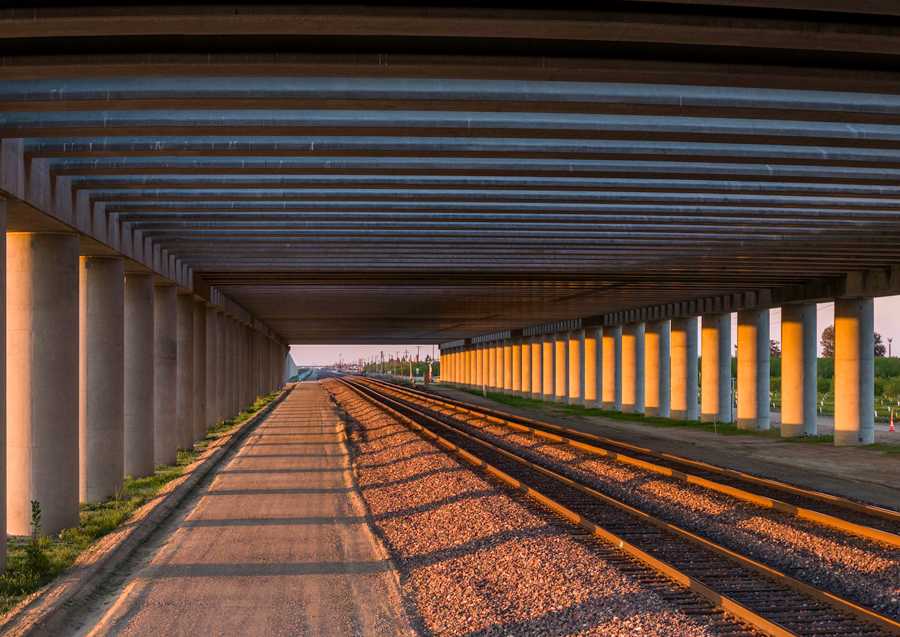
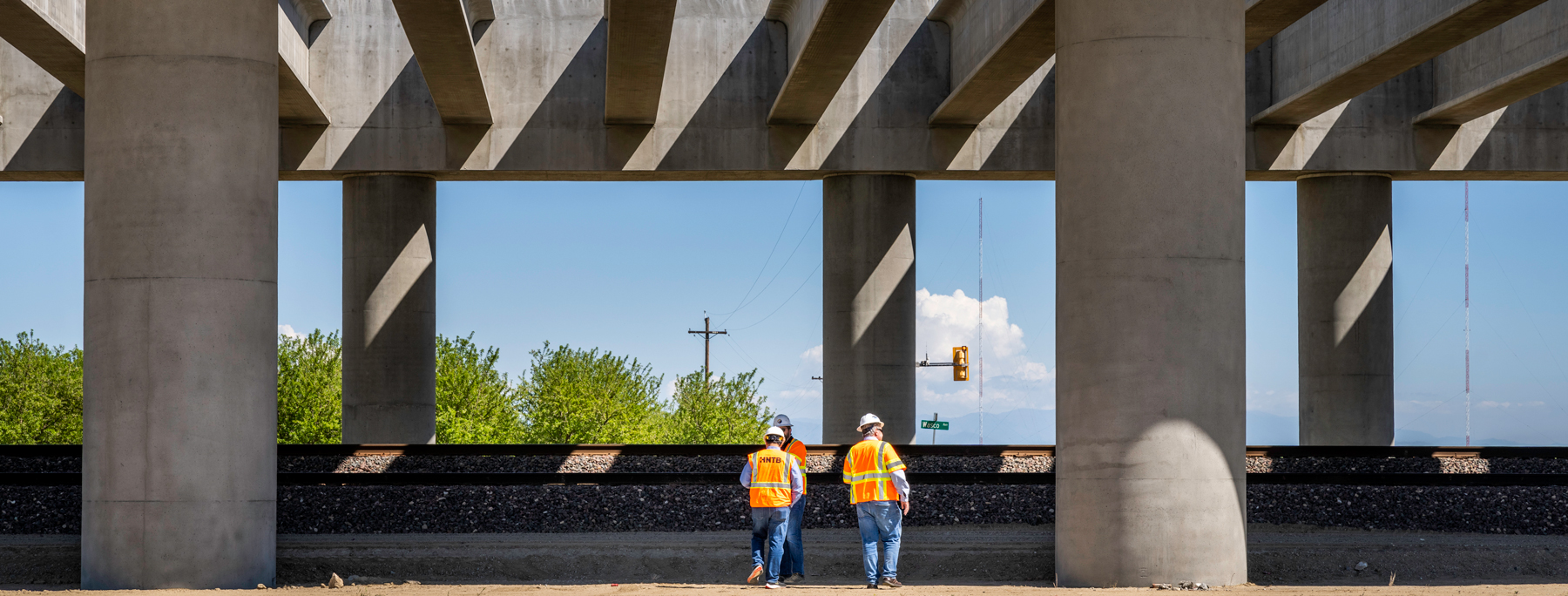
CONTACTS
Alberto King
HNTB Project Executive
(213) 337-2115
Brian Stover
HNTB Project Manager
(704) 577-0786
SEE MORE ARTICLES
MORE DESIGNER STORIES
Orlando International Airport Terminal C
Fish Passage
Denver International Airport A-West and B-West Concourses
CID Green Infrastructure Project
KC Levees Program
